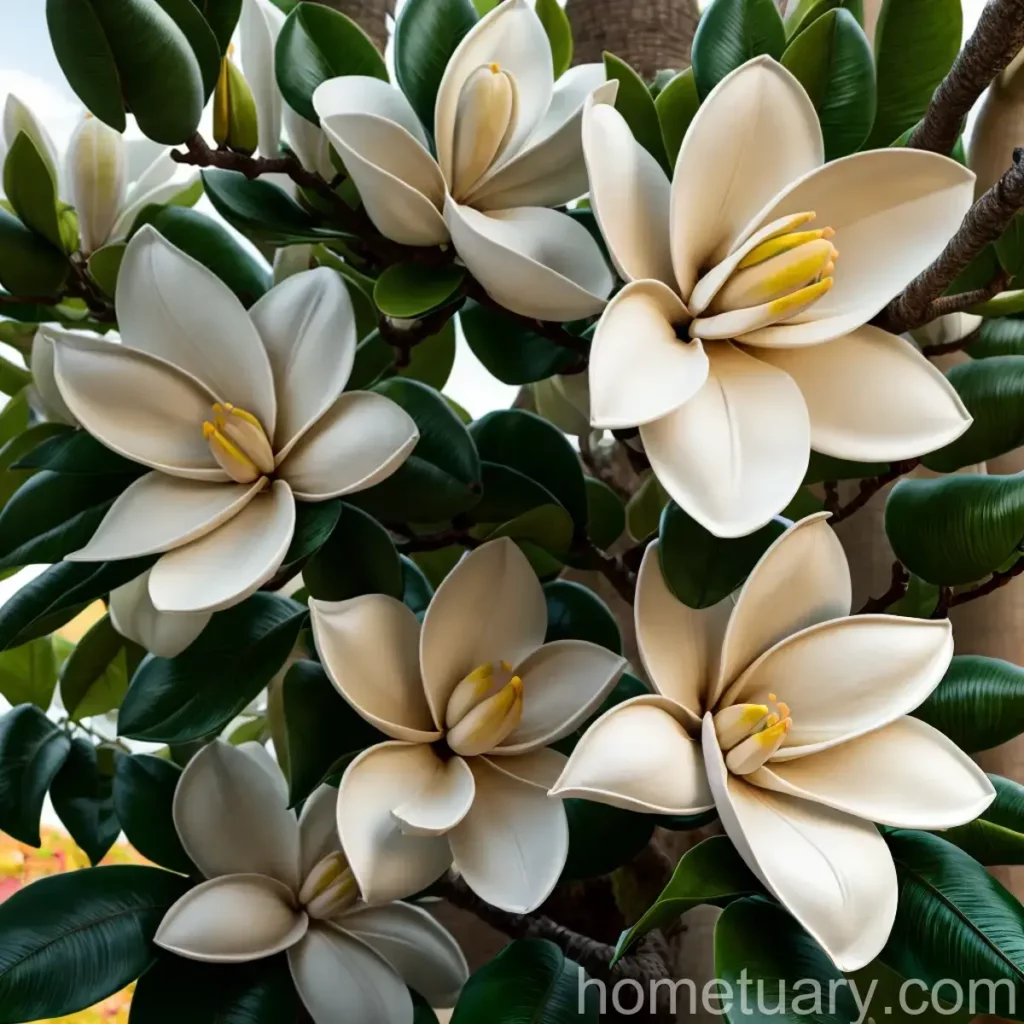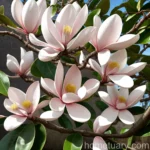The Large-Flowered Magnolia (Magnolia grandiflora ‘Edith Bogue’): A Comprehensive Guide
Introduction to the Large-Flowered Magnolia
The Large-Flowered Magnolia, scientifically known as Magnolia grandiflora ‘Edith Bogue’, is an exquisite cultivar that is cherished for its captivating, fragrant blossoms. This evergreen magnolia is celebrated for its striking large, creamy white flowers and lush, glossy foliage, making it a popular choice for gardens, landscapes, and ornamental focal points.
In this comprehensive guide, we will delve into the various aspects of this magnificent plant, encompassing its culture, uses, growth requirements, maintenance, common diseases and pests, propagation techniques, and much more. Whether you are a seasoned horticulturist or a novice gardener, this guide aims to provide valuable insights into the care and cultivation of the Large-Flowered Magnolia, imparting a deeper understanding of this spectacular species.
Key Takeaways
Before delving into the specifics of the Large-Flowered Magnolia, let’s briefly recap the key takeaways, underscoring the significance and appeal of this remarkable plant:
- Scientific Name: Magnolia grandiflora ‘Edith Bogue’
- Common Names: Large-Flowered Magnolia, Edith Bogue Magnolia, Bogue Magnolia, Southern Magnolia
- Plant Type: Evergreen Tree / Shrub
- Characteristics: Large, fragrant, creamy white flowers; Glossy, dark green foliage
- Uses: Ornamental focal point in landscapes, Gardens, Container gardening
- Growth Requirements: Adequate water, Full to partial sunlight, Well-draining soil, Fertilization
- Maintenance: Pruning, Disease and pest control, Watering, Fertilization
- Propagation: Seed propagation, Stem cuttings
- Popularity: Widely cultivated in Southern United States and beyond
These key takeaways will guide our exploration as we navigate through the various aspects of the Large-Flowered Magnolia.
Culture
Uses
The Large-Flowered Magnolia (Magnolia grandiflora ‘Edith Bogue’) has a multitude of uses, owing to its captivating blossoms and striking foliage. Some of its primary uses include:
-
Ornamental Focal Point: The large and fragrant flowers, coupled with the glossy, dark green foliage, make it a stunning focal point in any landscape or garden. Its sheer beauty and elegance add an enchanting touch to any outdoor space.
-
Gardens and Landscapes: The Large-Flowered Magnolia is commonly utilized in gardens and landscapes to lend a touch of sophistication and natural charm. Its evergreen nature ensures year-round visual appeal.
-
Container Gardening: This magnolia variety is well-suited for container gardening, allowing individuals with limited space to relish its beauty on patios, balconies, and small gardens.
Water
Proper watering is essential for the health and vitality of the Large-Flowered Magnolia. While it is crucial to provide sufficient moisture, overwatering should be avoided to prevent waterlogged soil and potential root rot. Here are some key considerations regarding the watering needs of the magnolia:
-
Establishment Phase: During the initial phase after planting, the Large-Flowered Magnolia necessitates regular watering to encourage root establishment and growth. Adequate moisture is vital for the development of a robust root system.
-
Mature Plants: Once the plant is well-established, it displays moderate drought tolerance. However, in periods of prolonged dryness, regular watering is recommended to ensure optimal growth and flowering.
-
Watering Frequency: The frequency of watering may vary depending on factors such as soil composition, weather conditions, and the presence of mulch. In general, the soil should be kept consistently moist but not waterlogged.
-
Signs of Underwatering: Wilted or yellowing leaves, especially during hot and dry weather, may indicate insufficient water supply. In such instances, providing adequate water is crucial to prevent stress and promote overall health.
Sunlight
Adequate sunlight is indispensable for the thriving of the Large-Flowered Magnolia. As a sun-loving plant, it flourishes when provided with ample sunlight and may exhibit reduced vigor and flowering in shaded or low-light conditions. Consider the following aspects related to sunlight requirements:
-
Full Sun Exposure: The Large-Flowered Magnolia exhibits optimal growth and flowering when exposed to full sunlight. A minimum of 6 to 8 hours of direct sunlight per day is highly recommended for ensuring robust growth and profuse blooming.
-
Partial Sun: While the magnolia prefers full sun, it can also tolerate partial shade. However, it is essential to ensure that the plant receives a significant amount of direct sunlight even in partially shaded locations to support healthy growth and flower production.
-
Sunlight Protection: In regions with intense summer heat, providing some protection from harsh midday sun can be beneficial, especially during the initial establishment phase. This can be achieved through strategic placement or the use of shade cloth to diffuse sunlight.
Fertilizer
Proper fertilization contributes to the overall health, vigor, and flowering capacity of the Large-Flowered Magnolia. When utilized judiciously, fertilizers supply essential nutrients, promoting lush foliage and abundant blooms. Here’s a closer look at the fertilization practices for the magnolia:
-
Fertilizer Types: A balanced, slow-release fertilizer formulated for acid-loving plants is ideally suited for the Large-Flowered Magnolia. These formulations often contain a balanced ratio of nitrogen, phosphorus, and potassium along with essential micronutrients.
-
Fertilization Timing: Spring is the optimal time to initiate fertilization, ideally before the onset of new growth. Avoid fertilizing late in the growing season, as this may stimulate late-season growth that is susceptible to damage from frost or cold temperatures.
-
Application Method: Care should be taken to evenly distribute the fertilizer around the dripline of the magnolia, avoiding direct contact with the trunk to prevent potential burning. Watering the area after application aids in the dissolving and absorption of the fertilizer.
-
Frequency: Annual fertilization is generally sufficient for established magnolias. However, it is crucial to carefully monitor the plant’s response to the fertilizer and adjust the frequency and dosage as per specific requirements.
Soil
The soil composition and quality play a pivotal role in the overall well-being of the Large-Flowered Magnolia. An optimal growing medium provides a supportive environment for root development, nutrient uptake, and moisture retention. Consider the following soil-related pointers:
-
Acidic Soil: The magnolia thrives in well-draining, acidic soil with a pH range of approximately 5.5 to 6.5. Acidic soil fosters the efficient uptake of essential nutrients, particularly iron, and promotes healthy growth and flowering.
-
Soil Amendment: Incorporating organic matter such as compost, leaf mold, or well-rotted manure enriches the soil, enhancing its texture, structure, and fertility. This practice also aids in retaining moisture and supporting beneficial microbial activity.
-
Mulching: Applying a layer of organic mulch around the base of the magnolia helps conserve soil moisture, regulate soil temperature, and suppress weed growth. Additionally, as the mulch decomposes, it contributes to the improvement of soil structure and fertility.
-
Soil Drainage: Well-draining soil is paramount for preventing waterlogging, which can lead to root suffocation and various detrimental effects. To enhance drainage in heavy or clay soils, amending with coarse sand or organic matter can be beneficial.
Pruning
Pruning is an essential aspect of maintaining the shape, size, and overall health of the Large-Flowered Magnolia. Proper pruning practices not only help in achieving a desirable form but also aid in the removal of diseased or damaged branches. Here are some fundamental guidelines related to the pruning of the magnolia:
-
Pruning Timing: The magnolia is best pruned during the dormant season, which typically occurs in late winter to early spring. Pruning during this period minimizes the risk of interrupting the flowering cycle and allows for rapid wound healing and regrowth.
-
Deadheading: Removing spent flowers after the bloom period can promote a tidier appearance and prevent the formation of seed pods. This practice directs the plant’s energy towards growth and development rather than seed production.
-
Selective Pruning: Careful removal of dead or diseased branches, as well as any crossing or rubbing branches, is essential for maintaining an open canopy and good air circulation. Selective thinning can help reduce the risk of diseases and pest infestations.
-
Pruning Techniques: Employing proper pruning techniques, such as making clean cuts at the branch collar to facilitate swift healing, is integral. Use of sharp, sanitized pruning tools minimizes the risk of infections and promotes the plant’s recovery.
Propagation
The propagation of the Large-Flowered Magnolia can be accomplished through seed propagation or stem cuttings. Each method has its own set of requirements and techniques, and the choice of propagation method may often depend on the available resources, time, and specific objectives. Let’s explore these propagation methods in detail:
- Seed Propagation:
- Harvesting Seeds: Gather mature magnolia seeds from the seed pods when they turn red and begin to split open. Extract the scarlet-colored seeds for propagation.
- Seed Treatment: Prior to sowing, the seeds should undergo stratification to break dormancy. This involves cold treatment, typically in a moist medium, for a specified duration.
-
Sowing Procedure: Plant the stratified seeds in well-draining, sterile soil mix at a shallow depth. Maintain consistent moisture and warmth for successful germination.
-
Stem Cuttings:
- Cutting Selection: Choose healthy, non-flowering shoots for taking stem cuttings. The selected cuttings should exhibit vigorous growth and lack signs of disease or damage.
- Cutting Preparation: Cut 6 to 8-inch sections of stem, ensuring that each cutting possesses at least one set of leaves. Remove the lower leaves to expose the nodes where root development will occur.
- Rooting Medium: Insert the cuttings into a well-draining rooting medium, such as a blend of perlite and peat moss. Enclose the cuttings in a humidity-retaining environment to encourage the development of roots.
Container Popularity
The Large-Flowered Magnolia is a favored choice for container gardening, offering an elegant and eye-catching addition to patios, verandas, and small outdoor spaces. Its adaptability to container culture paves the way for individuals with limited garden space or those seeking the versatility of potted plants. The following aspects underscore the popularity of growing this magnolia variety in containers:
-
Space Efficiency: Container cultivation allows individuals with restricted garden space to partake in the beauty of the Large-Flowered Magnolia. The plant’s ornamental attributes and modest growth habit make it an ideal candidate for pot culture.
-
Portability: The maneuverability of potted magnolias enables gardeners to position the plants strategically, creating captivating focal points or seasonal displays. Furthermore, containers offer the flexibility to relocate the plant in response to environmental conditions or design preferences.
-
Urban Gardening: In urban settings where outdoor space is at a premium, container gardening serves as a valuable avenue for integrating natural elements and greenery. The Large-Flowered Magnolia contributes to the aesthetic appeal and charm of urban landscapes and rooftop gardens.
-
Aesthetic Appeal: The presence of a potted magnolia, adorned with its large, fragrant flowers and glossy foliage, adds a touch of opulence and natural beauty to outdoor living spaces, elevating the overall ambiance and visual allure.
Container Maintenance
Successful container cultivation necessitates attentive maintenance and care to ensure the well-being and longevity of the Large-Flowered Magnolia. Addressing specific requirements related to container gardening will contribute to the plant’s health and performance. Consider the following maintenance guidelines for potted magnolias:
-
Container Size: Selecting an appropriately sized container is crucial for accommodating the magnolia’s root system and providing ample space for growth. A container with sufficient drainage holes facilitates proper aeration and moisture regulation.
-
Potting Mix: Employ a high-quality, well-draining potting mix with adequate aeration and water retention properties. The mix should be formulated for acid-loving plants to align with the magnolia’s soil preferences.
-
Watering Regimen: Containerized magnolias may require more frequent watering, especially during hot and dry periods. Regular monitoring of soil moisture and consistent watering are instrumental in sustaining optimal growing conditions.
-
Fertilization: Applying a balanced, slow-release fertilizer at the commencement of the growing season can supply essential nutrients for the potted magnolia. Adjusting the fertilizer dosage in accordance with plant growth and overall health is advisable.
-
Root Insulation: In regions with extreme temperature fluctuations, insulate the container during winter to protect the magnolia’s roots from freezing. Wrapping the pot with insulating materials or relocating it to a sheltered area can help safeguard the roots.
Common Diseases
The Large-Flowered Magnolia is susceptible to certain diseases that can affect its overall vigor and aesthetic appeal. Familiarizing oneself with these potential diseases enables early detection and effective management strategies to mitigate their impact. Let’s explore some common diseases that may afflict the magnolia:
-
Anthracnose (Colletotrichum sp.): Anthracnose manifests as irregularly shaped, dark lesions on the foliage and stems. In severe cases, it can lead to defoliation and twig dieback. The disease thrives in moist conditions and can be managed through sanitation and fungicidal treatments.
-
Leaf Spot (Pseudocercospora magnoliae): Leaf spot is characterized by the appearance of brown or yellowish spots on the leaves, often accompanied by premature leaf drop. Maintaining good air circulation and practicing proper sanitation aids in controlling this disease.
-
Powdery Mildew (Microsphaera sp.): Powdery mildew presents as a white, powdery coating on the foliage, typically in shaded and humid environments. Adequate spacing, removal of infected plant material, and fungicidal applications can help in suppressing powdery mildew.
-
Root Rot (Phytophthora sp.): Root rot, caused by various Phytophthora species, can lead to root decay, wilting, and decline. Preventing waterlogging, improving soil drainage, and incorporating fungicidal treatments are vital for managing this destructive disease.
-
Bacterial Blight (Pseudomonas sp.): Bacterial blight results in water-soaked lesions on the leaves and stems, often accompanied by wilting and dieback. Pruning affected branches, enhancing airflow, and avoiding overhead watering assist in minimizing bacterial blight incidence.
Disease Diagnosis
Accurately diagnosing diseases afflicting the Large-Flowered Magnolia is essential for implementing targeted control measures and preventing the spread of pathogens. The following diagnostic guidelines serve as a valuable resource for identifying and addressing potential diseases:
-
Symptom Recognition: Thorough observation of the plant for characteristic symptoms such as leaf spots, lesions, wilting, or unusual discoloration forms the basis of disease diagnosis.
-
Pathogen Identification: Identifying the specific pathogen responsible for the observed symptoms aids in selecting appropriate disease management strategies. This may involve microscopic analysis or diagnostic tests.
-
Environmental Conditions: Considering the prevailing environmental factors, including moisture levels, temperature, and air circulation, is integral in understanding disease development and progression within the magnolia.
-
History and Observations: Taking into account the plant’s history, previous disease occurrences, and any relevant observations contributes to a comprehensive understanding of the current disease situation.
-
Professional Consultation: Seeking the expertise of plant pathologists or horticultural professionals can provide valuable insights and laboratory analysis, facilitating precise disease diagnosis and management.
Common Pests
In addition to diseases, the Large-Flowered Magnolia may encounter various pests that can impair its growth and vitality. Familiarity with common pests and their characteristic symptoms aids in early detection and control. Several prevalent pests that may affect the magnolia include:
-
Scale Insects (Hemiptera: Coccoidea): Scale insects appear as small, waxy or shell-like protrusions on the stems and leaf undersides. They can cause stunted growth, leaf yellowing, and excretion of honeydew. Horticultural oils or insecticidal treatments can be effective in managing scales.
-
Spider Mites (Tetranychidae): Spider mites are minuscule arachnids that feed on the plant’s sap, leading to stippled or bronzed foliage. Increased monitoring and periodic application of miticides provide control over spider mite infestations.
-
Magnolia Scale (Neolecanium cornuparvum): Magnolia scale, often found on the twigs and branches, can induce leaf yellowing, wilting, and reduced plant vigor. Systemic insecticides or horticultural oils can aid in mitigating magnolia scale populations.
-
Leafminers (Lepidoptera: Gracillariidae): Leafminer larvae create intricate, serpentine patterns within the leaves, potentially compromising their photosynthetic function. Cultural practices and targeted insecticides contribute to leafminer management.
-
Magnolia Serpentine Leafminer (Phyllocnistis magnolia): The presence of serpentine mines on the foliage, indicative of magnolia serpentine leafminer activity, warrants attention. Pruning infested branches and employing biological control agents offer effective management options.
Botanist’s Tips
To ensure the successful cultivation and maintenance of the Large-Flowered Magnolia (Magnolia grandiflora ‘Edith Bogue’), here are some insightful tips from botanists and horticulture experts:
-
Soil Preparation: Prior to planting, thoroughly assess and amend the soil to align with the magnolia’s preference for acidic, well-draining soil. Conduct a soil pH test and incorporate organic matter as needed.
-
Mulching Practices: Apply a layer of organic mulch around the base of the magnolia, extending outwards from the trunk. Maintain a mulch-free zone around the immediate base to prevent moisture-related issues.
-
Watering Consistency: Establish a consistent watering regimen during the establishment phase, focusing on maintaining optimal soil moisture levels. Monitor the plant’s response to watering and adjust as necessary.
-
Pruning Considerations: When pruning the magnolia, prioritize the removal of crossing or congested branches to enhance airflow and reduce disease susceptibility. Ensure that pruning cuts are made at the proper angle near the branch collar.
-
Integrated Pest Management: Integrate biological control agents, such as beneficial insects, and employ cultural practices, such as plant sanitation and habitat modification, as components of a holistic pest management strategy.
-
Environmental Adaptation: Be cognizant of local climatic conditions and adapt cultivation practices to accommodate regional environmental variations and seasonal changes.
Fun Facts
Uncover some intriguing and insightful fun facts about the Large-Flowered Magnolia, shedding light on its unique characteristics and historical significance:
-
Fragrant Blooms: The Large-Flowered Magnolia is renowned for its intensely fragrant blossoms, emitting a delightful citrusy perfume that captivates and enthralls garden enthusiasts and passersby alike.
-
Southern Symbolism: The magnolia holds a special place in Southern culture and serves as a symbol of hospitality, purity, and the enduring charm















